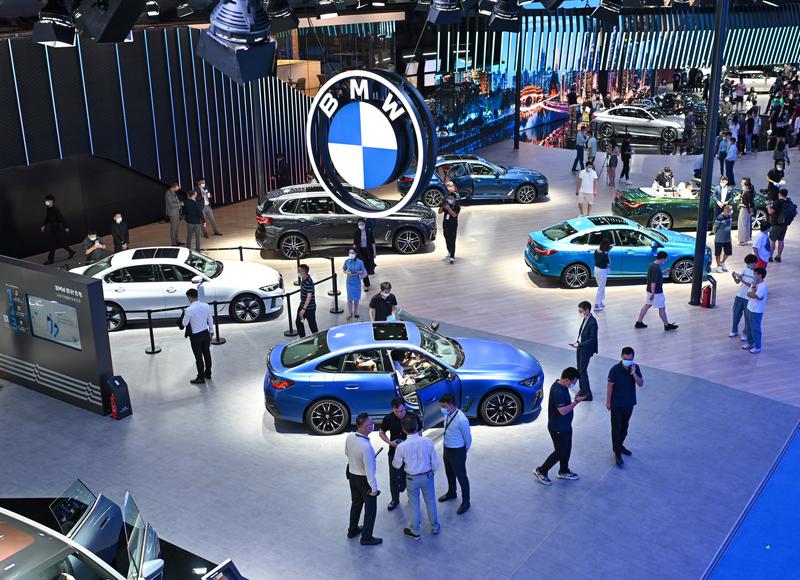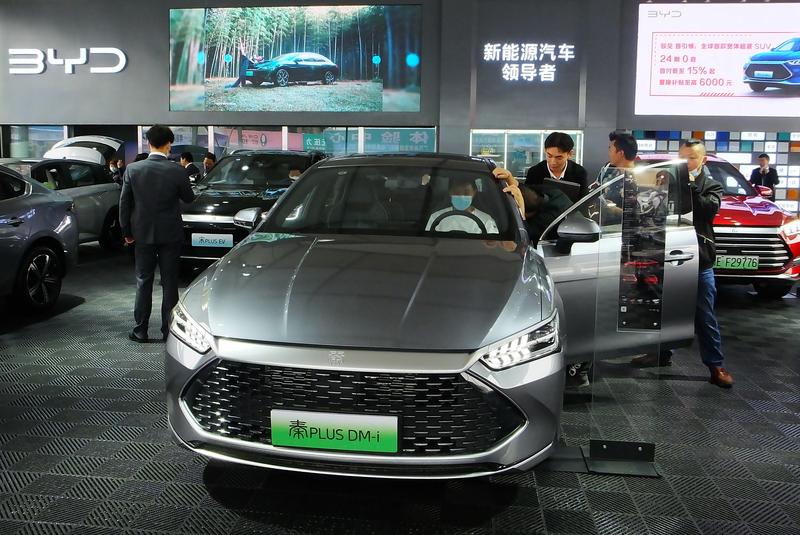CAAM says NEV boom on track to deliver better performance this year
 BMW showcases its models at the Chengdu auto show in Southwest China's Sichuan province in late August. (PHOTO PROVIDED TO CHINA DAILY)
BMW showcases its models at the Chengdu auto show in Southwest China's Sichuan province in late August. (PHOTO PROVIDED TO CHINA DAILY)
Vehicle sales continued their momentum into October, which has made the country's leading industry association optimistic that total sales this year will be up by 3 percent from 2021.
Carmakers sold 2.51 million vehicles last month, said the China Association of Automobile Manufacturers on Thursday.
This was 4 percent less than September but up 6.9 percent year-on-year, said the CAAM. Both September and October are usually peak months for car sales in China.
The October sales numbers brought total deliveries in the first 10 months of this year to 21.98 million units across the country, up 4.6 percent from the same period of 2021. The growth rate was 0.3 percentage points higher than that of the first three quarters.
Of the October sales, passenger vehicles totaled 2.23 million, up 10.7 percent from the same month last year. Their deliveries from January to October totaled 19.22 million, up 13.7 percent year-on-year.
Chen Shihua, deputy secretary-general of the CAAM, said the passenger vehicle segment has seen a rapid rise since June, when the central authorities came up with the favorable purchase tax.
Chen said the segment is expected to drive total sales in the country this year to exceed 27 million units, which will mark a 3 percent rise from 2021.
China-made premium vehicles including those from Audi, BMW and Mercedes-Benz saw their deliveries go up 12.5 percent year-on-year to 340,000 units in October. Their total deliveries soared 10.6 percent year-on-year in the first 10 months to 3.08 million units.
Chen said the upward spiral in the passenger vehicle segment was also buoyed by the popularity of new energy vehicles, including electric cars and plug-in hybrids, as well as rising exports.
Sales of electric cars and plug-in hybrids stood at 714,000 units last month, up 81.7 percent year-on-year. They accounted for 28.5 percent of total vehicle deliveries in October.
NEV sales from January to October reached 5.28 million units, up 110 percent year-on-year. They are expected to reach 6.5 million this year.
 A customer sits inside a BYD Qin Plus model in Yichang, Hubei province, in May. (LIU JUNFENG / FOR CHINA DAILY)
A customer sits inside a BYD Qin Plus model in Yichang, Hubei province, in May. (LIU JUNFENG / FOR CHINA DAILY)
BYD sold more than 200,000 vehicles in October, a new record for the Guangdong province-based NEV carmaker. It has been the most popular carmaker in China for three months in a row.
Its total sales in the first 10 months totaled 1.39 million vehicles, up 233.92 percent year-on-year.
Delivery numbers at Tesla's Shanghai plant reached 71,704 vehicles in October, up 32 percent from a year earlier, the United States electric carmaker said on Wednesday.
It delivered 554,778 vehicles in the first 10 months of 2022, far exceeding the 484,130 units delivered during the whole of 2021.
Chinese electric car startup Nio sold 10,059 vehicles in October, up 174.3 percent, despite production at its plants in East China's Anhui province being disrupted by COVID-19. It had delivered 92,493 vehicles from January to October, up 32 percent year-on-year.
William Li, chairman and CEO of Nio, said the carmaker will launch five new models in the first half of 2023. "By June, we will have eight models on sale to meet the demands of different customer groups. We are confident in our performance," he said on Thursday.
But as the authorities are stopping subsidies for NEVs by the end of this year, many carmakers are starting to explore the potential of hybrids as well as plug-in hybrids, which are powered by engines and thus less dependent on charging facilities.
China's vehicle exports hit a monthly record in October, with 337,000 units shipped overseas. Of them, around one-third were NEVs, up 81.2 percent year-on-year.
Exports in the first 10 months reached 2.46 million units, up 54.1 percent year-on-year. They were already higher than total vehicle exports for the whole of 2021.
NEVs have been a driving force, with their growth hitting 96.7 percent year-on-year to 499,000 units from January to October.
Tesla alone exported 219,427 vehicles during the January-October period, according to Tesla China. The localization rate of the industrial chain of Tesla's Shanghai plant has exceeded 95 percent, said Tao Lin, vice-president of Tesla.
Statistics from the CAAM show that Belgium, the United Kingdom and Thailand were the top three destinations for China-made NEVs in the first three quarters this year.
Chile sat atop the list of China's vehicle export destinations, with 179,000 shipped into the South American country from January to September. It was followed by Mexico at 178,000 units and Saudi Arabia, at 155,000 units.


